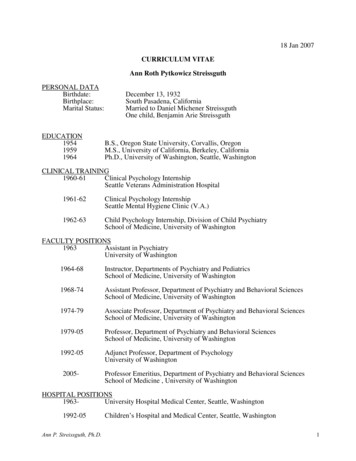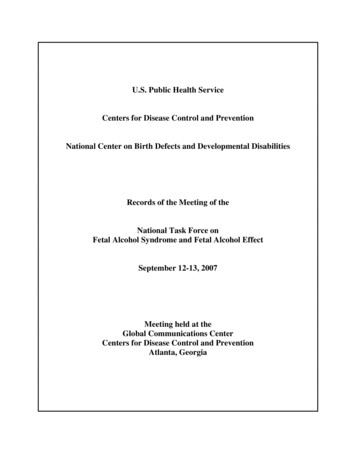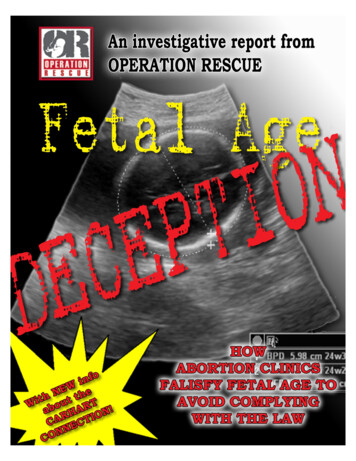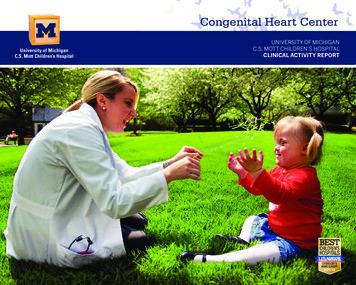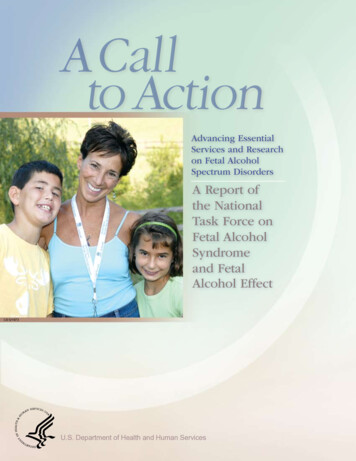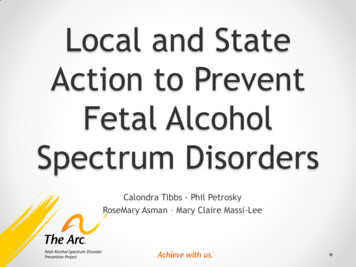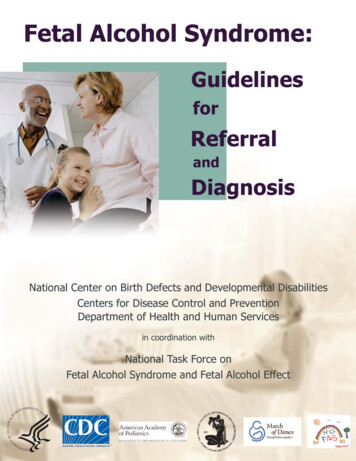
Transcription
Fetal Alcohol Syndrome:Guidelines for Referral andDiagnosisNational Center on Birth Defects and Developmental DisabilitiesCenters for Disease Control and PreventionDepartment of Health and Human Servicesin coordination withNational Task Force on Fetal Alcohol Syndrome and Fetal Alcohol EffectAmerican Academy of PediatricsAmerican College of Obstetricians and GynecologistsMarch of DimesNational Organization on Fetal Alcohol SyndromeJuly 2004(2nd printing, August 2004)(3rd printing, May 2005)DEPARTMENT OF HEALTH AND HUMAN SERVICESCenters for Disease Control and PreventionJulie Louise Gerberding, M.D., M.P.H., DirectorNational Center on Birth Defects and Developmental DisabilitiesJosé Cordero, M.D. M.P.H., DirectorDivision of Birth Defects and Developmental DisabilitiesFetal Alcohol Syndrome Prevention TeamR. Louise Floyd, D.S.N., R.N., Team Leader
ContentsAcknowledgements . . . . . . . . . . . . . . . . . . . . . . . . . . . . . . . . . . . . . . . . . . .ivForeword . . . . . . . . . . . . . . . . . . . . . . . . . . . . . . . . . . . . . . . . . . . . . . . . . . . .vExecutive Summary . . . . . . . . . . . . . . . . . . . . . . . . . . . . . . . . . . . . . . . . . . . .vBackground . . . . . . . . . . . . . . . . . . . . . . . . . . . . . . . . . . . . . . . . . . . . . . . . . .1Approach and Methods for Development of Guidelines . . . . . . . . . . . .4Diagnostic and Referral Framework . . . . . . . . . . . . . . . . . . . . . . . . . . . . . .7Diagnostic Criteria . . . . . . . . . . . . . . . . . . . . . . . . . . . . . . . . . . . . . . . . . . . . .9Criteria for FAS Diagnosis . . . . . . . . . . . . . . . . . . . . . . . . . . . . . . . . . . . . . .19Considerations for a Referral for an FAS Diagnostic Evaluation. . . . .21Services Appropriate for Affected Individuals and their Families . . . . .22Identifying and Intervening with Women at Risk for anAlcohol-Exposed Pregnancy . . . . . . . . . . . . . . . . . . . . . . . . . . . . . . . . . . .28Summary and Future Steps . . . . . . . . . . . . . . . . . . . . . . . . . . . . . . . . . . . .37References . . . . . . . . . . . . . . . . . . . . . . . . . . . . . . . . . . . . . . . . . . . . . . . . . .39iii
AcknowledgementsNational Task Force on Fetal Alcohol Syndrome and Fetal Alcohol Effect (NTFFAS/FAE):Kristen L., Barry, Ph.D., Department of Veterans Affairs; James E. Berner, M.D., Alaska NativeTribal Health Consortium; Raul Caetano, M.D., Ph.D., M.P.H., University of Texas School ofPublic Health; Faye B. Calhoun, D.P.A., M.S., NIAAA; Michael E. Charness, M.D., HarvardMedical School; Deborah E. Cohen, Ph.D., New Jersey Office for Prevention of MentalRetardation and Developmental Disabilities; Claire D. Coles, Ph.D., Marcus Institute; JoséCordero, M.D. M.P.H., NCBDDD; Chris Cunniff, M.D., University of Arizona; Karla Damus,R.N., Ph.D., March of Dimes; Nancy L., Day, Ph.D., University of Pittsburgh; Jocie C. Devries,FAS Family Resource Institute; Louise Floyd, D.S.N., R.N., NCBDDD; Mark B. Mengel, M.D.,M.P.H., St. Louis University School of Medicine; Lisa Miller, M.D., M.S.P.H., Colorado Respondsto Children with Special Needs; Kathleen T. Mitchell, MHS, LCADC, National Organization onFAS; Raquelle Myers, J.D., National Indian Justice Center; Edward Riley, Ph.D., San Diego StateUniversity; Luther K. Robinson, M.D., SUNY Buffalo School of Medicine; Charles M. Schad,Ed.D., University of South Dakota; Robert J. Sokol, M.D., Wayne State University; Daniel C.Vinson, M.D., M.S.P.H., University of Missouri; Jean A. Wright, M.D., Backus Children’sHospital.Scientific Advisory Panel: Herb Bischoff, Ph.D., Project Alaska; Julia M. Bledsoe, M.D., Universityof Washington; Larry Burd, Ph.D., North Dakota FAS Center; Tom Donaldson, NationalOrganization on FAS; Daniel Dubovsky, M.S.W., FAS Center for Excellence; Sheila Gahagan,M.D., F.A.A.P., University of Michigan; Marian Kummer, M.D., National Committee of Childrenwith Disabilities; Carole M. Lannon, M.D., M.P.H., National Initiative for Children’s HealthcareQuality; Theresa Maresca, M.D., Family Practice Physician; Sarah McGovern, B.A., NationalInitiative for Children’s Healthcare Quality; Uday C. Mehta, M.D., M.P.H., UMDNJ-RWJMedical School; Colleen A. Morris, M.D., University of Nevada School of Medicine; Rick L.Olson, M.D., Greenwood Genetic Center; Natalie E. Roche, M.D., New Jersey Medical School;Thomas F. Tonninges, M.D., F.A.A.P., American Academy of Pediatrics.Scientific Working Group: Susan J. Astley, Ph.D., University of Washington; Jacquelyn Bertrand,Ph.D., NCBDDD; Heather Carmichael Olson, Ph.D., University of Washington; Jocelynn L.Cook, Ph.D., M.B.A., Health Canada; Chris Cunniff, M.D., University of Arizona; . Louise Floyd,D.S.N., R.N., NCBDDD; Lewis B. Holmes, M.D., Massachusetts General Hospital for Children;Kenneth Lyons Jones, M.D., University of California School of Medicine; Kathleen T. Mitchell,MHS, LCADC, National Organization on FAS; Mary O’Connor, Ph.D., University of Californiaat Los Angeles; Edward Riley, Ph.D., San Diego State University; Luther K. Robinson, M.D.,SUNY Buffalo School of Medicine; Kenneth R. Warren, Ph.D., NIAAA. Mary Kate Weber,M.P.H., NCBDDD.CDC/NCBDDD Participants: Martha Alexander, M.A., M.P.H.; Hani K. Atrash, M.D.; JacquelynBertrand, Ph.D.; Carol Cabal, Ph.D.; José Cordero, M.D. M.P.H.; Yvette Dominique, M.S.; LarryEdmonds, M.S.P.H.; Paul Fernoff, M.D., F.A.A.P.; R. Louise Floyd, D.S.N., R.N.; Connie Granoff;Melissa Hogan. M.I.S.; Karen Hymbaugh, M.P.H.; Cynthia Moore, M.D., Ph.D.; Elizabeth ParraDang, M.P.H.; Jorge Rosenthal, Ph.D., M.P.H.; Tanya Sharpe, Ph.D., M.S.; Jasjeet Sidhu, M.D.,M.P.H.; Mary Kate Weber, M.P.H.; Marshalyn Yeargin-Allsopp, M.D.Prepared and edited by: Jacquelyn Bertrand, Ph.D.; R. Louise Floyd, R.N., D.S.N.; Mary KateWeber, M.P.H.; Mary O’Connor, Ph.D; Kay A. Johnson, M.P.H., Ed.M; Edward Riley, Ph.D.;Deborah E. Cohen, Ph.D.iv
ForewordThe National Center on Birth Defects and Developmental Disabilities at the Centers for DiseaseControl and Prevention, in collaboration with the National Task Force on Fetal Alcohol Syndromeand Fetal Alcohol Effect, is pleased to present Fetal Alcohol Syndrome: Guidelines for Referral andDiagnosis. This document represents the deliberations of clinicians, researchers, parents, and repre sentatives of governmental and non-governmental organizations, whose main goals were to increasethe identification of individuals with fetal alcohol syndrome (FAS) using uniform criteria, and toimprove the delivery of appropriate services to those individuals and their families. These newguidelines will help achieve those goals by educating medical and allied health professionals aboutFAS.In 2003, we, in the FAS research and practice communities, celebrated the 30th anniversary of thefirst reports describing fetal alcohol syndrome. Since that time we have learned a great deal aboutthis preventable condition. We now recognize that FAS represents the tip of the iceberg and thatthere is a continuum of outcomes associated with prenatal exposure to alcohol. These guidelineswere undertaken, in part, as an effort to facilitate further identification, understanding, and studyof all conditions resulting from prenatal exposure to alcohol. They build on previous work andincorporate important scientific and clinical knowledge that has been obtained in recent years.CDC is pleased to provide continuing support for the expansion and refinement of scientificdescriptions for FAS and other disorders related to prenatal exposure to alcohol through its ongoingwork with the National Task Force on Fetal Alcohol Syndrome and Fetal Alcohol Effect and thefederal Interagency Coordinating Committee on Fetal Alcohol Syndrome (ICCFAS).Preventing all adverse outcomes associated with prenatal alcohol exposure remains a primary goal ofCDC, as well as the entire U.S. Department of Health and Human Services. CDC is committed toworking with other federal agencies, organizations in the private sector, relevant partners, and thepublic to achieve this goal. Similarly, CDC is committed to enhanced early identification of indi viduals with FAS and related disorders to ensure their access to appropriate services. These latestguidelines for referral and diagnosis are an important step towards that goal. Together we willensure all persons with FAS and related disorders develop optimally and reach their full potential.José F. Cordero, M.D., M.P.H.Assistant Surgeon GeneralDirectorNational Center on Birth Defects and Developmental Disabilitiesv
Fetal Alcohol Syndrome: Guidelines for Referral and Diagnosisvi
Fetal Alcohol Syndrome:Guidelines for Referral and DiagnosisEXECUTIVE SUMMARYAs part of the fiscal year 2002 appropriations funding legislation, the U.S. Congress mandated thatthe Centers for Disease Control and Prevention (CDC), acting through the National Center onBirth Defects and Developmental Disabilities (NCBDDD) Fetal Alcohol Syndrome (FAS)Prevention Team and in coordination with the National Task Force on Fetal Alcohol Syndrome andFetal Alcohol Effect (NTFFAS/FAE), other federally funded FAS programs, and appropriate non governmental organizations, would: Develop guidelines for the diagnosis of FAS and other negative birth outcomes resulting fromprenatal exposure to alcohol, Incorporate these guidelines into curricula for medical and allied health students and practition ers, and seek to have them fully recognized by professional organizations and accrediting boards,and Disseminate curricula to and provide training for medical and allied health students and practi tioners regarding these guidelines.Through the coordinated efforts of CDC, the NTFFAS/FAE, and a scientific working group(SWG) of experts in FAS research, diagnosis, and treatment, the following diagnostic criteria weredeveloped over a 2-year period:Facial dysmorphiaBased on racial norms, individual exhibits all three characteristic facial features: Smooth philtrum(University of Washington Lip-Philtrum Guide rank 4 or 5) Thin vermillion border(University of Washington Lip-Philtrum Guide rank 4 or 5) Small palpebral fissures(at or below 10th percentile )Growth problemsConfirmed prenatal or postnatal height or weight, or both, at or below the 10th percentile, docu mented at any one point in time (adjusted for age, sex, gestational age, and race or ethnicity).Central Nervous System AbnormalitiesI. Structural1) Head circumference (OFC) at or below the 10th percentile adjusted for age and sex.2) Clinically significant brain abnormalities observable through imaging.vii
Fetal Alcohol Syndrome: Guidelines for Referral and DiagnosisII. NeurologicalNeurological problems not due to a postnatal insult or fever, or other soft neurological signsoutside normal limits.III. FunctionalPerformance substantially below that expected for an individual’s age, schooling, or circum stances, as evidenced by:1. Global cognitive or intellectual deficits representing multiple domains of deficit (or significantdevelopmental delay in younger children) with performance below the 3rd percentile (2 stan dard deviations below the mean for standardized testing)or2. Functional deficits below the 16th percentile (1 standard deviation below the mean for stan dardized testing) in at least three of the following domains:a) cognitive or developmental deficits or discrepanciesb) executive functioning deficitsc) motor functioning delaysd) problems with attention or hyperactivitye) social skillsf ) other, such as sensory problems, pragmatic language problems, memory deficits, etc.Maternal Alcohol ExposureI. Confirmed prenatal alcohol exposureII. Unknown prenatal alcohol exposureCriteria for FAS DiagnosisRequires all three of the following findings:1. Documentation of all three facial abnormalities (smooth philtrum, thin vermillion border,and small palpebral fissures);2. Documentation of growth deficits3. Documentation of CNS abnormalityA primary goal of these guidelines is to provide standard diagnostic criteria for FAS so that consis tency in the diagnosis can be established for clinicians, scientists, and service providers. The guide lines are based on state-of-the-art scientific research, clinical expertise, and family input regardingthe physical and neuropsychological features of FAS. The SWG sought to harmonize these guide lines with other diagnostic systems currently in use in this country and others (e.g., Canada). TheSWG strove to provide a balance between conservative and overly inclusive diagnostic systems.Differential diagnosis from other genetic, teratological, and behavioral disorders was emphasized.In addition to diagnostic guidelines, guidance about medical, educational, social, and family servic es appropriate for individuals with FAS and their families are reviewed. Services that are applicableto all individuals with FAS and their families, as well as age-specific services, are included. Suchservices focus on increasing parent and professional knowledge of FAS, characteristics of the disor viii
Fetal Alcohol Syndrome: Guidelines for Referral and Diagnosisder, differences between FAS and other disorders, and appropriate techniques for parenting or edu cating affected individuals.Prevention of FAS and related disorders is of tremendous public health importance. A large amountof research in recent years has enabled researchers and service providers to develop programs thatare effective and targeted to specific populations for reducing the risk of an alcohol-exposed preg nancy, which prevents FAS. This research is reviewed herein and recommendations for identifyingand intervening with women at risk for an alcohol-exposed pregnancy are provided.Finally, these guidelines are not intended to be an endpoint in the discussion of diagnosing FAS.There is a great need to acquire science-based information that will facilitate diagnostic criteria foradditional related disorders, such as Alcohol Related Neurodevelopmental Disorder (ARND). Theseguidelines conclude with a call for further research and continuous refinement of the diagnostic cri teria for FAS and related conditions so that affected individuals and their families can receiveimportant services that enable them to achieve healthy lives and reach their full potential.ix
Fetal Alcohol Syndrome: Guidelines for Referral and Diagnosisx
Fetal Alcohol Syndrome:Guidelines for Referral and DiagnosisSubstantial empirical and clinical scientific evidence has shown that prenatal exposure to alcoholcauses damage to the developing fetus. Such exposure is commonly cited as the leading preventablecause of birth defects and developmental disabilities (1-3). Children* exposed to alcohol duringfetal development can suffer multiple effects. While the number and severity of negative effects canrange from subtle to serious, the negative consequences are lifelong. The effects of prenatal exposureto alcohol and basic diagnostic features of fetal alcohol syndrome (FAS) were first described in theUnited States (U.S.) medical literature 30 years ago (4-8). In 1981, the U.S. Surgeon Generalissued a public health advisory warning that alcohol use during pregnancy could cause birth defects(9). Further, mandated labeling of alcohol products was established in 1989 (10). Despite theknown adverse effects of prenatal exposure to alcohol, many children who experience these adverseeffects do not receive proper diagnosis due to the absence of current diagnostic guidelines. Thesecurrent guidelines, which were federally mandated of the Centers for Disease Control andPrevention (CDC) in the U.S. Department of Health and Human Services (DHHS) 2002Appropriations Bill, seek to update and refine diagnostic and referral criteria in light of the scientif ic and clinical advances in the understanding of this disorder during the past 30 years.These guidelines are organized into several sections. Background information and a history of thedevelopment of these guidelines are presented. Next, revised and refined diagnostic and referral cri teria for FAS are described, including the empirical and clinical evidence that support each criteri on. Comparison of these guidelines with other diagnostic methods currently in use is provided.Because diagnosis is not the endpoint for most clinicians who see children with FAS, a discussion ofthe essential services for affected individuals is included. Likewise, prevention of FAS by reducingthe number of alcohol-exposed pregnancies is inherent in dealing with the disorder. Therefore, adiscussion focused on identifying and intervening with women at risk for an alcohol-exposed preg nancy is provided. Finally, a discussion of future needs and efforts related to FAS and other prenatalalcohol-related disorders conclude this report.BACKGROUNDPrevalence. Studies by CDC have reported FAS prevalence rates from 0.2 to 1.5 cases per 1,000births across various populations (11-14). Other studies reflecting a variety of ascertainmentmethodologies have produced estimates ranging from 0.5 to 2.0 cases per 1,000 live births (15-16).Such rates are comparable with or above other common developmental disabilities such as Downsyndrome or Spina Bifida (17). Using the CDC FAS estimates, among the approximately 4 millioninfants born each year, an estimated 1,000 to 6,000 will be born with FAS. Studies of particularlyvulnerable populations yield prevalence estimates that far exceed those of other common disabili ties. Disadvantaged groups, Native Americans, and other minorities have been documented to have* Although referral and diagnosis for FAS can be made throughout the lifespan, the majority of individuals are referredand diagnosed in childhood. Thus, the terms “child” or “children” as used in these guidelines are not intended to pre clude referral, assessment, and diagnosis of older individuals.1
Fetal Alcohol Syndrome: Guidelines for Referral and Diagnosisrates as high as three to five FAS affected children per 1,000 children (18-20). Available data alsosuggest that poverty is strongly associated with women’s alcohol use before and during pregnancy,leading to an excess of children with FAS in impoverished groups (21-22).The magnitude of the problem is even greater when the risk of FAS is considered by looking at therate of alcohol-exposed pregnancies. In 1999, over half of all U.S. women of childbearing agereported alcohol consumption in the past month (23). The large majority of these women drankonly occasionally, but 15% could have been classified as moderate or heavy drinkers (24-25).During that same period, 13% of women reported consuming five or more drinks on one occasion(binge drinking) in the past month (26). Given that nearly half of all U.S. pregnancies are unin tended, and that millions of fertile women are sexually active while not using adequate contracep tion, an estimated 2% of women could be at risk for an alcohol-exposed pregnancy annually (27).More recently, higher rates have been found among subgroups of women, such as those treated foralcohol and drug problems, and women who have been incarcerated (28). Alcohol-related risk fac tors include drinking during pregnancy, pattern of alcohol use, alcohol dependence, use of multiplesubstances, having had a previous alcohol-exposed pregnancy, and having a partner or family mem ber who drinks heavily (29-31). Women who receive little or no prenatal care, are unemployed, aresocially transient, have lost children to foster or adoptive care because of neglect, abuse, or aban donment are more likely to have high alcohol use patterns that could affect a pregnancy (22,32).National survey data indicate that, while the percentage of women who abstain from alcohol useduring pregnancy has increased slightly in recent years, 13% of women continue to use alcoholduring pregnancy (26). Among pregnant women, approximately three percent report binge drink ing (i.e., five or more drinks on any one occasion) or frequent drinking (i.e., seven or more drinksper week or five or more drinks on any one occasion) (1,33-34). Clearly, current prevalence rates ofaffected individuals and alcohol-exposed pregnancies indicate that the magnitude of the problem ofFAS is a significant public health concern. However, because of the challenges of establishing accu rate and timely prevalence information, the magnitude could be even greater than current dataindicate.Challenges in determining accurate prevalence. Despite the progress made over the past severaldecades to accurately establish and monitor the prevalence of FAS, the full magnitude of the prob lem is still not known. Primary care providers and others who care for children do not routinely orconsistently identify individuals with FAS, which hinders efforts to account for these children inroutine birth defects and developmental disabilities monitoring programs. Studies using multipledata sources (e.g., birth certificates, clinical charts, and medical records) show wide variations inidentification of FAS cases depending on the population being surveyed (15,34). Four major factorslead to widespread failure to recognize FAS in primary pediatric care settings resulting in underesti mates of the prevalence and impact of FAS (36-38): No specific and uniformly accepted diagnostic criteria have been available. The four broad areasof clinical features that constitute the diagnosis of FAS have remained essentially the same sincefirst described in 1973: selected facial malformations, growth retardation, Central NervousSystem (CNS) abnormalities, and maternal alcohol consumption during pregnancy. These fourareas were reaffirmed in a 1996 report by the Institute of Medicine (IOM; 39-40). However,these broad areas of diagnostic criteria are not sufficiently specific to ensure diagnostic accuracy,consistency, and reliability . For example, clinicians do not have guidance about how many facialfeatures must be present or the timing and severity of growth retardation needed to constitute2
Fetal Alcohol Syndrome: Guidelines for Referral and DiagnosisFAS diagnostic criteria. Thus, health providers are hampered in their efforts to screen and identifychildren with FAS. FAS diagnosis is based on clinical examination of features, but not all children with FAS lookor act the same. Because each of the symptoms has a broad range of differential diagnoses, it iseasy for a clinician to miss or misdiagnose FAS. Previous guidelines, including those included inthe 1996 IOM report, did not account for children of different racial and ethnic groups or indi viduals of different ages . In addition, symptoms such as growth impairment, cognitive impair ment, and learning disabilities can have a range of causes. Some of these causes or disorders havehigher visibility and recognition than FAS, leading to misdiagnosis (or at least failure to includeFAS in the total diagnosis). For instance, physicians are aware of the high prevalence of AttentionDeficit, Hyperactivity Disorders (ADHD), but might not link attention problems to FAS.Without clear diagnostic criteria and instruction on their use, providers will continue to underidentify and under-diagnose FAS. Lack of knowledge and misconceptions among primary care providers. Many professionalsbelieve that FAS can only occur if the mother is an alcoholic. Few know about the full range orprogressive nature of the neurobehavioral symptoms that result from prenatal exposure to alcohol.Some incorrectly believe that FAS only occurs among low-income families or in Native Americanor other racial and ethnic minority groups (21). Better information on the impact of FAS amongall populations and dissemination of race or ethnic variations in the diagnostic criteria can helpclinicians understand the risk of prenatal alcohol exposure across populations. Knowledge aboutsubpopulation variations in facial characteristics as well as growth curves for infants by gestationalage also are important considerations (41). Lack of diagnostic criteria to distinguish FAS from other alcohol-related conditions. Creatingand using diagnostic guidelines for FAS is a starting point for better defining the continuum ofconditions related to prenatal alcohol exposure (40). FAS is a severe outcome of prenatal alcoholexposure. Other outcomes also occur and can result in major deficits. Terms such as Fetal AlcoholEffect (FAE), Alcohol-related Birth Defect (ARBD), and Alcohol-Related NeurodevelopmentalDisorder (ARND) have been used to describe a spectrum of conditions related to prenatal alcoholexposure.These four challenges indicate that what is urgently needed to advance the field of FAS diagnosisare current diagnostic guidelines based on empirical evidence as well as clinical experience. Suchguidelines should be based on up-to-date scientific evidence and current clinical practices. Further,such guidelines would allow public health and service professionals to better determine the impactof FAS, and deliver needed services to affected children.Congressional mandate. As part of the fiscal year 2002 appropriations funding legislation, Congressmandated that CDC, acting through the National Center on Birth Defects and DevelopmentalDisabilities (NCBDDD) and in coordination with the National Task Force on Fetal AlcoholSyndrome and Fetal Alcohol Effect (NTFFAS/FAE ), other federally funded FAS programs, andappropriate nongovernmental organizations, would: Develop guidelines for the diagnosis of FAS and other negative birth outcomes resulting fromprenatal exposure to alcohol;3
Fetal Alcohol Syndrome: Guidelines for Referral and Diagnosis Incorporate these guidelines into curricula for medical and allied health students and practition ers, and seek to have them fully recognized by professional organizations and accrediting boards;and Disseminate curricula to and provide training for medical and allied health students and practi tioners regarding these guidelines.Limit in scope. The mandate to CDC indicates that, in addition to guidelines for FAS, guidelinesshould be developed for other negative birth outcomes resulting from prenatal exposure to alcohol.However, it was subsequently determined through discussions with all interested stakeholders thatthe best course was to first develop guidelines for the full FAS diagnosis (see following). Then, insubsequent efforts, these guidelines could be expanded or refined to include other alcohol-relateddisorders. This approach was determined to provide the most timely and scientifically groundedguidelines at this time. However, this decision does not curtail ongoing efforts to define conditionsbeyond FAS or develop diagnostic guidelines for those conditions.Note on terminology. Many terms are used to describe the continuum of effects that result from pre natal exposure to alcohol, including: Fetal Alcohol Effect, Alcohol-related Birth Defects, andAlcohol-Related Neurodevelopmental Disorder. A more recent term that has been introduced isFetal Alcohol Spectrum Disorders (FASD). In April 2004, several federal agencies [(NationalInstitutes of Health (NIH), CDC, & Substance Abuse and Mental Health Services Administration(SAMHSA)] along with experts in the field were convened at a summit sponsored by the NationalOrganization on FAS (NOFAS) to develop a consensus definition of FASD. The resulting defini tion, adopted in these guidelines, is:Fetal Alcohol Spectrum Disorders (FASD) is an umbrella term describing the range of effects that canoccur in an individual whose mother drank alcohol during pregnancy. These effects may includephysical, mental, behavioral, and/or learning disabilities with possible lifelong implications. The termFASD is not intended for use as a clinical diagnosis.APPROACH AND METHODS FOR DEVELOPMENT OF GUIDELINESTo meet its Congressional mandate, CDC convened an internal working group, led by staff fromthe FAS Prevention Team of NCBDDD, to conduct preplanning meetings to determine the bestmethods for development of all aspects of the guidelines: (a) general framework for referral anddiagnosis, (b) development of guidelines for physical features (dysmorphia and growth) as well asexposure, and (c) development of guidance to clinicians concerning potential CNS abnormalities.Each of these aspects involved review of the literature, as well as discussions with consultants, clini cians, researchers, and parents of affected children. A description of general and specific methods ofdevelopment of each aspect follows.General review of literature. CDC staff identified various reports and documents to be used as thescientific basis for diagnostic guidelines. The science base for this work included, but was not limit ed to:4
Fetal Alcohol Syndrome: Guidelines for Referral and Diagnosis Published scientific, peer-reviewed, literature on physical and neurodevelopmental effects of pre natal exposure to alcohol; The report of the IOM Committee to study FAS (40); Results from the work of the NTFFAS/FAE (42) ; Criteria from standard, widely used dysmorphology and neurodevelopmental textbooks or guides(40,43-44); Research on measuring the FAS facial phenotype (45-47); Reports on systems that operationally interpret the 1996 IOM criteria(48-50); Experience in developing a surveillance case definition for the Fetal Alcohol SyndromeSurveillance Network (FASSNET) (51); Ongoing state surveillance and research data, particularly work of Alaska (19,35,52), Colorado(53), New Jersey, Nevada, Washington, and the Four State FAS Consortium (consisting of NorthDakota, Montana, Minnesota, and South Dakota); The American Academy of Pediatrics (AAP) August 2000 statements and recommendations onFAS and other effects related to maternal alcohol use (54); Position of the American Academy ofFamily Physicians, which refers to the AAP statement; and Canadian National Committee’s efforts concerning standardization of guidelines for screening,diagnosis, and surveillance of FAS.Framework. Bef
The National Center on Birth Defects and Developmental Disabilities at the Centers for Disease Control and Prevention, in collaboration with the National Task Force on Fetal Alcohol Syndrome and Fetal Alcohol Effect, is pleased to present Fetal Alcohol
